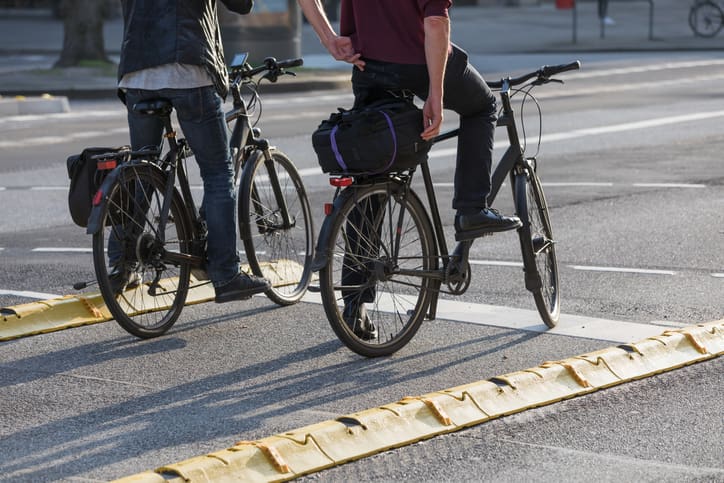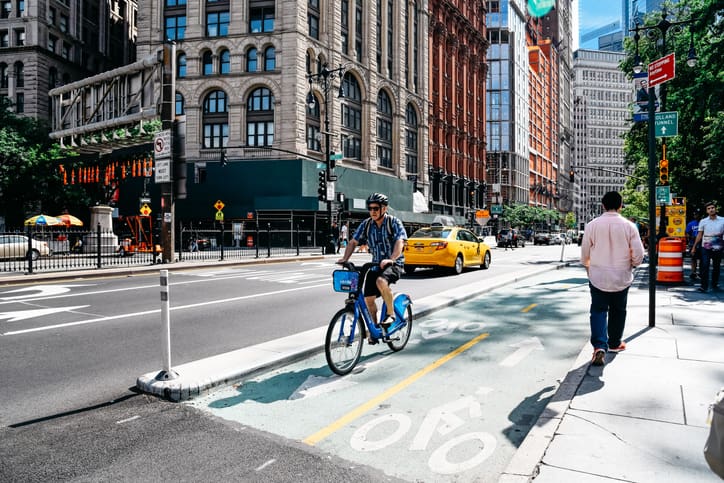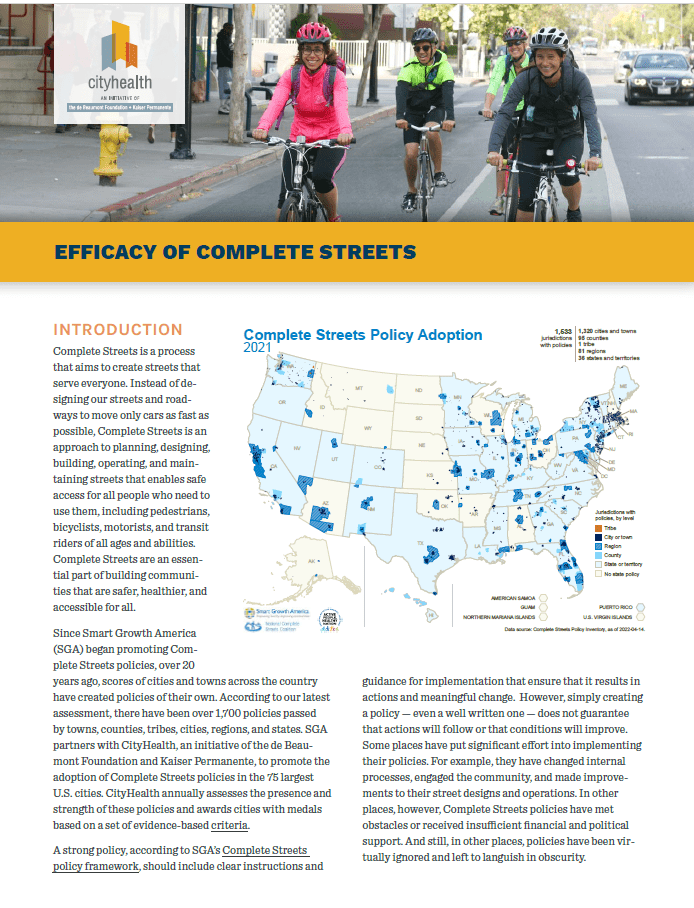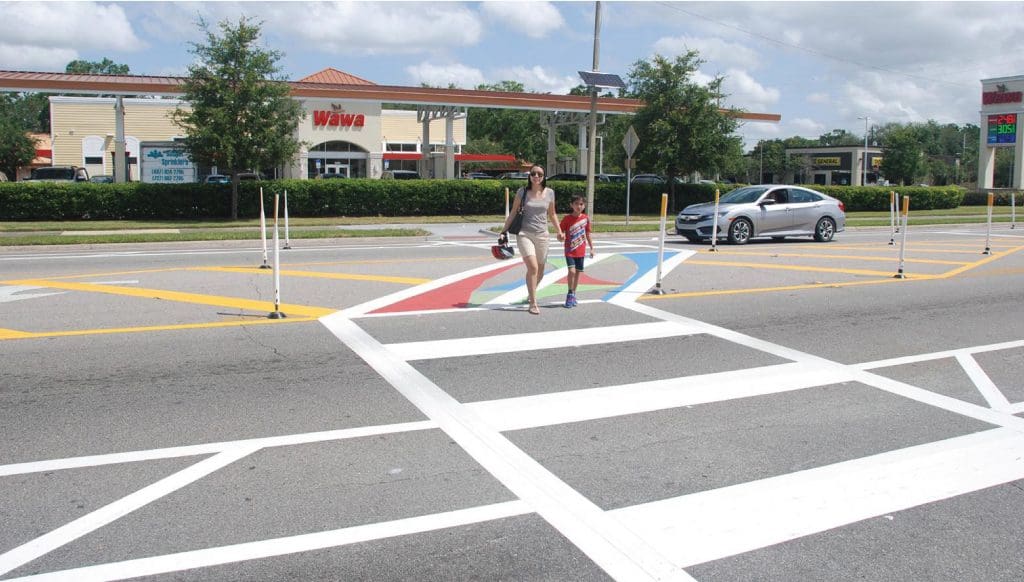Complete Streets is a process that aims to create streets that serve everyone. Instead of designing our streets and roadways to move only cars as fast as possible, Complete Streets is an approach to planning, designing, building, operating, and maintaining streets that enables safe access for all people who need to use them, including pedestrians, bicyclists, motorists, and transit riders of all ages and abilities.
Complete Streets are an essential part of building communities that are safer, healthier, and accessible for all. Since Smart Growth America (SGA) began promoting Complete Streets policies, over 20 years ago, scores of cities and towns across the country have created policies of their own. According to their latest assessment, there have been over 1,700 policies passed by towns, counties, tribes, cities, regions, and states.
Learn more about the criteria CityHealth uses to assess cities’ Complete Streets policies, and download the full guide here.
Produced in partnership with Smart Growth America.
A strong policy, according to SGA’s Complete Streets policy framework, should include clear instructions and guidance for implementation that ensure that it results in actions and meaningful change. However, simply creating a policy — even a well written one — does not guarantee that actions will follow or that conditions will improve. Some places have put significant effort into implementing their policies. For example, they have changed internal processes, engaged the community, and made improvements to their street designs and operations. In other places, however, Complete Streets policies have met obstacles or received insufficient financial and political support. And still, in other places, policies have been virtually ignored and left to languish in obscurity.
There are three key factors that help ensure that Complete Streets policies become stepping stones to healthier, safer communities and not just dusty documents with little impact. We also provide examples of types of barriers standing in the way of progress.
Three Key Factors
1. Strong leadership and champions
Keys to leadership and championing Complete Streets:
- Cultivate elected champions for Complete
Streets - Embrace and frame Complete Streets as a
central issue with multiple benefits. - Keep improving Complete Streets.
- Take advantage of all possible funding
sources, including federal funds. - Leverage data to identify priority areas and
to track progress.
Without political will and strong leadership, Complete Streets policies are less likely to have positive impacts. If the cause of improving streets does not have local champions, it can easily be pushed aside by other interests and issues. Therefore, it is crucial to have elected leaders such as mayors, councilmembers, or governors who will dedicate significant material and human resources to making Complete Streets a reality. Someone also needs to stand up for the cause when obstacles arise (e.g., when a few vocal car drivers complain that a Complete Streets improvement would affect their commute).
Mayor Satya Rhodes-Conway: Prioritizing Complete Streets and safety in Madison, Wisconsin
Madison has had a Complete Streets policy on the books since 2009. However, the safety and convenience of everyone who uses the streets have received significant attention under Mayor Satya Rhodes-Conway. Mayor Rhodes-Conway, elected in 2019 and reelected in 2023, has made street safety one of her top priorities.
In the past few years, the city has released a new Complete Green Streets Guide which provides guidance for implementing Complete Streets consistently over time, using a people-centered approach. The city also recently created a Vision Zero Action Plan to chart the city’s path toward eliminating all traffic deaths and serious injuries by 2035. But Mayor Rhodes-Conway’s actions in this area are not limited to these important planning documents. The city has built a number of projects to make Madison’s streets safer and more people-friendly. Examples include adding protected bike lanes, improved street lighting, high visibility crosswalks, pedestrian islands, and traffic calming measures throughout the city.
Thanks to work by the Rhodes-Conway administration as well as advocates and community organizations, Madison is one of the safest cities to be a pedestrian. The proportion of cars driving over the speed limit has decreased in most project areas. According to SGA’s most recent Dangerous By Design report, of the 101 largest metro areas in the country, Madison is the second safest in terms of pedestrian fatality rates. And the Madison case also shows that improving safety for pedestrians and bikes is good for everyone. Total crashes, fatalities, and serious injuries for all road users have been reduced as well.

Mayor Danene Sorace: Lancaster, Pennsylvania
Another mayor that has been leading the charge for better and safer streets is Danene Sorace of Lancaster, Pennsylvania. Elected in 2017 as just the second female mayor of Lancaster, Sorace has been pushing for safer and better streets. The city’s approach is informed by a crash data dashboard which maps all traffic crashes in the city and gives details such as contributing conditions, vehicle type, and people involved. A number of strategies and projects are notable. For instance, the city is creating interconnected pedestrian and bicycle lanes and off-street trails. Other improvements such as traffic calming, roundabouts, and ADA improvements demonstrate the city’s commitment.
These projects will only continue going forward. The city was recently awarded $12.7 million through the Safe Streets for All Grant — the largest competitive federal grant in the city’s history.
2. Make Complete Streets the default approach for all projects
Keys to making Complete Streets the default:
- Draft Complete Streets policies with language that covers all projects.
- Change internal processes to ensure that Complete Streets is the default approach. Click here to learn more.
- Modify or create other policies to support Complete Streets

Complete Streets should be the default approach for all projects, not something extra to add at the end of a project or an option that may be adopted in certain cases. This means Complete Streets are central to planning, design, construction, operation, and maintenance. The Complete Streets policy itself should clearly state that all projects should follow a Complete Streets approach. However, this is not a one-time action. Beyond the initial policy, subsequent actions including the creation of rules and procedures, staff training, data collection, evaluation, and more, should all treat Complete Streets as the modus operandi.
The Complete Streets policy of Minneapolis, adopted in 2021, clearly states that its principles should be followed in all projects, leaving no room for doubt about when and where it should be applied. In addition to the Complete Streets policy, however, the city has also adopted complementary policies and plans including a Transportation Action Plan, Street Design Guide, and Vision Zero Action Plan, all of which align with Complete Streets.
As a result, government departments prioritize pedestrians, bicycle riders, and transit users in new projects and street improvements thus creating environments that promote active transportation. In fact, 93% of streets in Minneapolis have sidewalks on both sides, and the city is
working to fill in all remaining gaps. In addition, the city has been implementing traffic calming measures such as speed humps, medians, curb extensions, and chicanes (the narrowing or turning of a road to reduce vehicle speeds).
These actions have helped make the Minneapolis metro region the third safest of all large metros for pedestrians according to our most recent Dangerous by Design report.
3. Build a network, not just individual projects
Keys to building a network:
- Connect different projects and communities through Complete Streets to create an integrated network.
- Measure access to important destinations via different travel modes to ensure equitable mobility throughout the city or town.
- Prioritize network improvements based on use and needs of communities.
For Complete Streets to be truly effective, it is important to have a comprehensive network. Piecemeal projects simply won’t do. An isolated sidewalk or bike path that ends abruptly does little to improve mobility for users. There must be a network of connected routes that allow everyone to travel between locations in a safe, efficient, and dignified way. Boston has embraced the network approach and made
significant progress in recent years. In the early 2000s, Boston was rated as one of the worst bicycling cities in the country, with only 200 feet of striped bike lanes. However, a shift of focus by mayoral administrations and city government dramatically improved the situation. The city’s 2013 Complete Streets Design Guidelines and Boston Bike Network Plan have helped the city create dozens of miles
of interconnected paths and routes, which the city aims to significantly expand in the coming years.
 The present network includes 59 miles of off-street paths, 17.5 miles of separated bike lanes, and 8 miles of neighborhood routes. These allow people to travel around and between neighborhoods to reach important destinations such as jobs, schools, grocery stores, and more.
The present network includes 59 miles of off-street paths, 17.5 miles of separated bike lanes, and 8 miles of neighborhood routes. These allow people to travel around and between neighborhoods to reach important destinations such as jobs, schools, grocery stores, and more.
Boston has also changed the way it approaches its sidewalk networks. Like many cities, Boston previously relied on 311 requests to determine the locations that needed to be repaired or improved. However, this produced inequitable results, as requests were disproportionately coming from higher-income neighborhoods where sidewalks were in relatively good condition while lower-income neighborhoods with worse sidewalks went unattended. In 2018, the city adopted a new approach which prioritizes projects based on foot traffic, demographics and social vulnerability, and the physical condition of sidewalks.
These approaches have helped make Boston a better city for moving around without a car. The overall walk and bike score for the city are 83 and 69 respectively. Furthermore, Boston-Cambridge-Newton consistently ranks as one of the safest metro areas in terms of pedestrian fatalities (7th-safest according to the most recent data).
Barriers to Efficacy
On the other hand, there are multiple obstacles that can hinder or prevent progress on Complete Streets. In this section we highlight some of the most common, and problematic obstacles, based on our experience of working with communities across the country.
State-owned arterials
Perhaps the most common issue facing many local jurisdictions is the fact that states control many of the roads inside their borders, and many of them are arterial roads that are among the most dangerous type of road in the U.S. Because the state owns these roads, local governments have little control or ability to make improvements, even if the route also serves as a main street through a downtown filled with people and a high density of destinations. Even the strongest local Complete Streets policies will have little impact on the state-owned or controlled roads that still prioritize speed over safety. These roadways are most often designed to move cars from one place to another as fast as possible, but a large number of people live, work and move around these areas (like a neighborhood street). This dangerous combination has deadly consequences. Over 60% of the people killed while walking are killed on non-freeway arterial roads. Local governments should collaborate with the state to address the two main factors — speed and road design. Lowering speeds and adding traffic calming or pedestrian infrastructure such as crosswalks and safety islands can significantly reduce the number and severity of pedestrian fatalities on arterials.
In some cases, the best solution is to transfer ownership of these roadways from states to local governments. This is a mutually beneficial arrangement as cities gain control over assets within their boundaries and states can reduce the amount of infrastructure they must maintain. The exact details of such transfers can vary, but states and local governments are striking deals in a wide range of places such as Portland, Oregon, Kalamazoo, Michigan, and Louisiana.
Status quo systems and processes
Inertia is a powerful factor in transportation development. Because our streets and roads have been built to prioritize moving cars quickly in nearly all contexts for the past half century, car dominance has become the status quo, and it can be difficult for governments as well as the general public to imagine doing things differently. For example, the speed limits on many roads and streets are set and adjusted based on how fast people drive, rather than safety. If drivers are regularly exceeding these limits, the response is simply to raise the limit. Changes always produce a level of anxiety, and if people have never experienced roads and streets designed to prioritize the safety of people outside of vehicles, the difference can sound jarring or scary. However, lowering speed limits and redesigning streets, if done strategically, usually has little impact on traffic congestion and is often broadly embraced. It also produces streets that are safer for people behind the wheel.
One way to ease this transition is through quick-build demonstration projects — temporary installations, often using low-cost materials, to test street design improvements. The benefits of this approach are manifold. For the public, quick builds allow everyone (including pedestrians and drivers) to experience improvements firsthand and to understand the benefits and impacts. On the government side, it allows planners and engineers (many of whom were trained in car-heavy curricula) to explore new ways of doing things. Cities and towns across the country have implemented quick-build projects including Durham, North Carolina, Lexington, Kentucky, and Wenatchee, Washington.
The other crucial way to ensure success is to involve ALL relevant stakeholders in the Complete Streets process, from drafting the policy all the way through implementation. For instance, if a city council drafts and adopts a policy without significant input and buy-in from the streets department or the department of public works, it is less likely to be successfully implemented. If instead, these and other relevant stakeholders like residents and community organizations are brought in from the beginning coordination can be more seamless and effective. Of course this increases the challenge, and will mean more work and coordination across departments, but it will be worth it.
The good news is inertia works both ways. Once you break a cycle, and establish new healthier and safer ways of doing things, they become the new status quo and the “way things are done.”
Piecemeal or inconsistent implementation
It is important to apply Complete Streets as broadly and uniformly as possible. In many places, however, we see piecemeal implementation and contradictions. For example, if exceptions are not clearly defined and regulated, Complete Streets principles can be disregarded. In other places we have seen Complete Streets elements applied unevenly, with some neighborhoods historically disconnected, underserved, and neglected. And there can also be clear contradictions. For example, if a city builds new bike lanes and sidewalks but also builds more parking and dangerous high-speed highways, this is not progress. Finally, there are also cases where Complete Streets elements are removed because of complaints from car drivers. Rather than an integrated Complete Streets network, this creates a patchwork of islands within a city or town.
exceptions are not clearly defined and regulated, Complete Streets principles can be disregarded. In other places we have seen Complete Streets elements applied unevenly, with some neighborhoods historically disconnected, underserved, and neglected. And there can also be clear contradictions. For example, if a city builds new bike lanes and sidewalks but also builds more parking and dangerous high-speed highways, this is not progress. Finally, there are also cases where Complete Streets elements are removed because of complaints from car drivers. Rather than an integrated Complete Streets network, this creates a patchwork of islands within a city or town.
As mentioned, a strong Complete Streets policy (with clear instructions and limited exceptions, specific implementation plans, and accountability measures) is an important first step to ensuring implementation. However, it is also important for all stakeholders to maintain momentum. On the government side, it’s crucial to have strong leaders who will champion Complete Streets and remain steady in their commitment. At the same time, community organizations and other civil society members should push government entities to ensure full implementation.
Conclusion
This report identifies some of the key factors that can enable or hinder successful implementation of Complete Streets. SGA and CityHealth partner with cities to adopt strong Complete Streets policies that lead to actual changes. Crafting the strongest possible policy that gives
guidance for implementation is a great first step, but considering these other barriers — and how to overcome them— is a smart second step. Connect with us to begin your Complete Streets journey.




